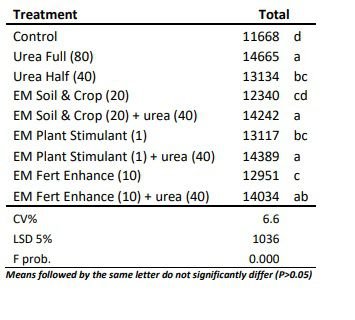Permanent pastures with a blend of clover and rye grass have been and remain the foundation of New Zealand’s intensive pastoral farming system. It is also our competitive advantage on the global market when combined with our temperate climate, clover is used to provide the majority of the nitrogen required for high production. In addition to its nitrogen–fixing abilities, clovers ability to persist and its high feed value (Animal performance has been shown to improve by up to 50 percent with increased clover content in pasture) only contribute to its importance. The potential nitrogen fixation rates from white clover are upwards of 300kg N/ha/year, depending on several factors – including the farm system, soil pH, and the 16 nutrients required for the optimal growth of white clover.
Over the last couple of decades we have seen a large increase in New Zealand in the quantities of nitrogen fertiliser has been applied to New Zealand pastures and many farms have developed a dependence on regular applications to maintain growth. This reliance on bagged nitrogen for high pasture yield is suppressing clover’s natural nitrogen–fixing ability and ultimately resulting in lower pasture productivity. Average nitrogen fixation from white clover in New Zealand is only 185kg N/ha/year.
With Agricultural sustainability a national priority. The impact of nitrogen leaching on New Zealand’s freshwater quality is a leading headline and topic of debate. Legislation has already started and nitrogen reductions will continue for many decades as the importance of our fresh water is now essential for the production of premium quality food for international markets. It goes without saying that within this landscape, it is inevitable that farmers will need to reduce their nitrogen applications. Clover, a natural nitrogen–fixer, presents a practical and cost–effective solution that can help reduce environmental impact while maintaining productivity – we can look to our past for tips on how to look after it properly including focussing on Sowing rates, establishment periods and soil nutrient profiles.
Using EM helps to increase the clover production
EM will stimulate clover growth. It does this through the following mechanisms in the soil:
- The microbes in EM help to mobilise nutrients and provide those that are essential for clover growth through the recycling of organic matter in the soil. This helps to create a fertile rhizosphere
- Production of PGR substances – EM has been shown to produce plant growth producing substances like auxins, cytokinin’s, enzymes, vitamins and gibberellins. These compounds increase the rate of seed germination and stimulate the development of root tissues; leading to an increase in the surface area of the roots. This increases the ability for the plant to access water and nutrients. The published data to the right (table 4) shows the microbes in EM and the plant growth regulators it produces.
- The microbes in EM also prevent and can change a negative soil environment. This occurs through outcompeting negative and disease inducing microbial species and also by antagonistic activities against soil borne plant pathogens.
- EM not only adds microbes to the soil but stimulates resident microbial activity. This goes a long way to enhancing plant growth, and this added biological activity in the rhizosphere promotes nodulation in the clover roots, and consequently increases symbiotic N fixation.
- One of the more well-known microbes in EM is photosynthetic bacteria. Photosynthetic bacteria in the soil enhances other microorganisms, for example, VA (vesicular-arbuscular) mycorrhiza in the rhizosphere is increased due to the availability of nitrogenous compounds (amino acids) for use as substrates secreted by Photosynthetic bacteria. VA mycorrhiza increases the solubility of phosphates in soils thereby supplying unavailable phosphorus to plants. VA mycorrhiza can coexist with Azotobacter as nitrogen fixing bacteria and enhance nitrogen fixing ability of legumes. Mycorrhizae fungi also increase the surface area associated with the plant root, which allows the plant to reach nutrients and water that otherwise might not be available. Mycorrhizae essentially extend plant reach to water and nutrients, allowing plants to utilize more of the resources available in the soil.
Trial Results
The recent Pasture trial independently conducted by PastureFirst titled - The evaluation of EMNZ Microbial products on the yield and composition of irrigated pasture, found that all three EM products (EM Soil and Crop, EM Fert Enhance and EM Plant Stimulant, showed that they have a positive effect on pasture production. While on their own the level of dry matter production was lower than that of high rates of nitrogen, in combination with lower rates of nitrogen they provide significant benefits. The total dry matter produced by combining each of the three EM products with 40kg urea/ha, was equivalent to that grown by applying 80kg urea/ha. This means that farmers can reduce their nitrogen inputs, but can grow equivalent amounts of pasture by adding in one of the EM products. This has significant production, economic and environmental benefits. The increased level of clover being able to be produced by implementing the above system, compared to high nitrogen systems, will also be a long-term benefit for pastoral farmers.
Table 1: Combined total dry matter yield (kgDM/ha) grown over trial period date (Sept 2021 – Apr 2022)

But by focusing on the clover numbers (Table 2) we can see some very positive impacts for farmers, with EM clearly showing it ability to stimulate the clover content within the pasture sward. As expected, the high rate of urea (80kg/ha) reduced clover content at both assessment dates, this is often seen in high nitrogen use systems. The low nitrogen rate (urea 40kg/ha) had no effect on clover content. EM however had a significant impact on clover content. It also showed that EM had a positive effect on enhancing the clover percentage when used alongside Urea. From this we can determine the average clover % of the sward for each treat and then the total amount of clover produced. Then we can see how much N is being fixed for each treatment and then how much value, based on the current cost of N, that fixed N is adding for the farmer. This shows that the EM treatments not only increase the clover content for each treatment but that they also add value to the farmers bottom line.
Table 2: Effect of each treatment on clover content, total N fixed and the value of that fixed N to the farmer.

Assumptions
2.58/kg/N
0.4% N in clover and 100% fixed
To review the Full Trial Report click here
Source link














